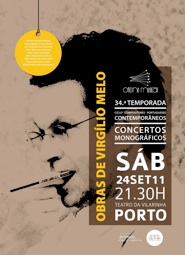|
|
>> Versão portuguesa |
| To Make Audible the Thinkable ÂNGELO MARTINGO |
2011.10.08 |
|
The following critical reflection constitutes an elaboration on some of the aspects concisely brought up by Álvaro Salazar in the concert’s introduction – Virgílio Melo is indeed an artistic personality of recognizable singularity and coherence. Although one shall not define here this singularity, it is surely worth presenting what makes it, and what it makes, evident – a tension between the literality of the text and the plurality of the sense, between the rigour of the writing and a kind of irreducible complexity, which it can transmit. In this context the outline is gained by the relevance and expressiveness of the electronics as well as instrumental conventional and extended techniques – fruit of an imagination, which voluntarily disciplines and restrains itself, essentially, to traditional instruments, yet not without exploiting them up to their limits. Having said that, the set of works in the programme – composed between 1985 and 2007, with around 5 years separating each piece – may be thought off as a representative selection of an artistic path, in which one can observe growth and stabilization in the exploration of compositional possibilities. From this point of view, and almost coincident with the golden rule, we would find in “Circuitus” (2000) a climax, in which the word, deprived of its significational values, emerges with a hallucinatory character in the heart of the music coming out of the instruments and the music, as if of an invisible hand, from the real-time electronics. The programme’s most recent work, “Canso Entrebescata II”, is more economical in means, presenting an informed and refined exploration of instrumental possibilities. The required performance virtuosity contrasts with the volume and spectacularity – it all happens, so it seems, in the body and on the surface of the instrument. In what could be understood as an extensive elaboration of the incommunicable – the friction of the hair and rosin on the instrument’s strings and bridge, the vibrating strings systematically producing harmonics – being extended up to 17 minutes, during which a forte sonority in rarely achieved. “A Glimpse of the Holy Darkness” reveals the same knowledge of instrumental possibilities as well as of efficient and balanced chamber writing technique. Points and phrases, served by conventional and extended instrumental techniques, are here articulated in a refined writing in which temporality emerges as an important element – phrases are rhythmically and successively set on an extended whole, in which a climax is rarely permitted. All this is found with the force of emerging things in “Nó”, the earliest piece from the programme. With a considerable duration, especially considering that it is written for a solo monophonic instrument, the piece manifests an exquisite construction and managing of musical tension, and of the articulation and succession of the phrases, in which the immateriality of breathing (pneuma), the materiality of the instrument and the sound continuum (with determined and indeterminate pitch) concur to a coherent and expressive whole. From the perspective on which this reconstruction of meaning is built, “A Tre” for three clarinets, remains a work apart on this programme. It is a more immediately evident work, as far as composing processes are concerned, and also more efficient from the communicative point of view – a compact 3-minute piece in a continuous mezzo-forte / forte register, which extinguishes in a long trill. To end up, a word to Oficina Musical – the recital was a part of the Contemporary Portuguese Composers Cycle integrated in the 34th season of this institution founded in 1978 by Álvaro Salazar, which, consistently and at an excellent level provides an invaluable service to Portuguese culture in the domain of contemporary music. |
|
 On September 24
On September 24